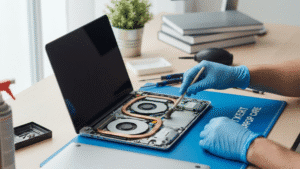Introduction:
A broken screen on your Android phone can be a frustrating and inconvenient problem, impacting both the usability and aesthetics of your device. Whether it’s a cracked display, unresponsive touchscreen, or shattered glass, dealing with a broken screen requires prompt attention and effective solutions. In this comprehensive guide, we’ll explore various methods and techniques for fixing a broken screen on your Android phone, helping you restore functionality and regain control of your device.

Understanding the Severity of Screen Damage:
Before delving into the solutions, it’s essential to assess the severity of the screen damage on your Android phone. Screen damage can range from minor cracks and scratches to more significant issues such as a completely shattered display or unresponsive touchscreen. Understanding the extent of the damage will help determine the most appropriate course of action for repair.
Common Causes of Screen Damage:
- Accidental Drops: Accidentally dropping your phone on hard surfaces such as concrete or tile floors is one of the most common causes of screen damage.
- Impact or Pressure: Applying excessive pressure or force to the phone’s screen, such as sitting or stepping on it, can lead to cracks or damage.
- Mishandling: Rough handling, tossing, or throwing the phone can result in screen damage, especially if it impacts a solid object.
- Manufacturing Defects: In some cases, screen damage may occur due to underlying manufacturing defects or weaknesses in the phone’s construction.
Now, let’s explore the steps to fix a broken screen on your Android phone:
- Assess the Damage:
- Carefully examine the extent of the screen damage, noting any cracks, shattered glass, or areas of discoloration.
- Check if the touchscreen is still responsive to touch gestures or if there are any dead spots where the screen does not register input.
- Assess whether the damage is limited to the screen itself or if there are additional issues with the phone’s functionality.
- Backup Data:
- Before attempting any repairs or modifications, it’s crucial to back up your data to prevent data loss in case of further complications during the repair process.
- Use cloud storage services, such as Google Drive or Dropbox, or connect your phone to a computer to transfer important files, photos, contacts, and other data.
- Temporary Fixes for Minor Damage:
- If the screen damage is minor, such as small cracks or scratches, you may be able to apply temporary fixes to prevent further damage.
- Apply a clear screen protector or tempered glass screen protector to cover the damaged areas and provide added protection against scratches.
- Avoid using the phone in extreme temperatures or environments that could exacerbate the damage, such as exposing it to water or humidity.
- DIY Screen Repair Kits:
- DIY screen repair kits are available for purchase online or at electronics stores and contain all the tools and materials needed to replace a broken screen.
- Follow the instructions provided with the repair kit carefully, as the process may vary depending on the make and model of your Android phone.
- Be prepared for a potentially challenging and delicate repair process, as replacing a phone screen requires precision and patience.
- Professional Screen Replacement:
- If you’re uncomfortable or inexperienced with DIY repairs, or if the screen damage is extensive, it’s advisable to seek professional screen replacement services.
- Contact the manufacturer of your Android phone or visit an authorized service center to inquire about screen replacement options and pricing.
- Professional technicians have the expertise and specialized equipment needed to safely and effectively replace the screen on your Android phone.
- Consider Insurance or Warranty Coverage:
- If your Android phone is still under warranty or if you have insurance coverage, check if screen damage is included in your policy.
- Some warranties may cover screen repairs or replacements for a nominal fee, while insurance plans may require a deductible or additional charges for screen damage claims.
- Review the terms and conditions of your warranty or insurance policy to understand coverage limitations and eligibility criteria.
- Preventive Measures for Future Protection:
- Once the screen has been repaired or replaced, take preventive measures to protect your Android phone from future damage.
- Use a durable phone case or protective cover to cushion the phone against drops and impacts.
- Apply a screen protector or tempered glass screen guard to add an extra layer of protection against scratches and cracks.
- Handle your phone with care and avoid exposing it to situations or environments that could potentially damage the screen.
Revive your phone’s vitality with our expert mobile repair services! ????✨ Visit our website www.digimob.com.au to learn more and schedule your appointment today!

Conclusion: Dealing with a broken screen on your Android phone can be a challenging experience, but with the right approach and resources, you can effectively address the issue and restore functionality to your device. Whether you opt for DIY repairs using screen repair kits, seek professional screen replacement services, or utilize insurance or warranty coverage, it’s important to prioritize safety and precision throughout the repair process. By following the steps outlined in this guide and taking preventive measures to protect your phone from future damage, you can prolong the lifespan of your Android device and enjoy uninterrupted usage for years to come.



